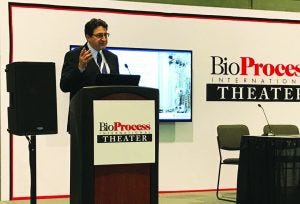- Sponsored Content
- Contract Services
Emerging Technologies and Strategies to Accelerate Process Development and Time to MarketEmerging Technologies and Strategies to Accelerate Process Development and Time to Market
August 21, 2018
Sponsored by AGC Biologics
 Gustavo Mahler, president and chief executive officer, AGC Biologics
Gustavo Mahler, president and chief executive officer, AGC Biologics
AGC Biologics is one of the largest global biologics contract development and manufacturing organizations (CDMO) specializing in clinical and commercial development of therapeutic proteins. It has developed more than 200 products, both mammalian and microbial, from preclinical to commercial on all scales. The company’s CGMP facilities are located in the United States, Europe, and Japan.
AGC Biologics’s technologies and strategies to accelerate time to market include standardized cell-line and cell-bank creation and use of high-throughput technology for process and analytical development needed to apply for an investigational new drug (IND). By using a standardized quality by design (QbD) approach to process validation and high-throughput technology for process characterization, the company can accelerate process characterization. It also will assist clients in creating a long-term production strategy.
When developing your cell line, do not take shortcuts. Use a strategy that will produce a solid cell line with good expressions titers and quality parameters (including the ability to do early screening), is a stable and known entity to regulatory agencies, and has an acceptable host-cell protein (HCP) profile. Also, use the same partner that created your cell lines to develop your CGMP cell banks to ensure a fast track for cell bank testing.
Once you have developed your cell line, you must think about process development. The use of high-throughput upstream and downstream technology (such as ambr 250 and Tecan technologies, respectively) can reduce process development timelines to under three months. Further reductions in time can be had by using high-throughput analytics such as the Octet system. Metabolomics can help you optimize your process based on nutrient depletion. Another time saver is a one-step scale-up in which a CDMO can go from a 5-L confirmation run to 2,000 L without intermediate scales. These technologies and abilities can work within a timeline from DNA to IND in 12–18 months.
Mahler presented a case study showing a 14-month timeline that included how long each step took, which steps could overlap, and what technologies were used to accomplish it. Even better, he said, shorter timelines save money.
To accelerate process characterization and validation, use a standardized QbD approach to process validation and lock in the process and analytics before phase 3. Characterizing each unit operation using fractional factorial design also saves time and cost. First, identify critical quality attributes (CQA) and perform a risk assessment. Then perform multifactorial screening of process parameters and a detailed design of experiments (DoE) based on relevant parameters. To prevent delays and complexity with validation batches, plan all ancillary validations as part of your phase 3 batches. Finally, remember the 5 Ps of marketing: “proper planning prevents poor performance.” Plan out how to accomplish all processes and testing requirements, and spell out the reason for each step. Using high-throughput technologies also will save you time in process characterization.
The next challenge is selecting the right scale for the first several years after launch. If you begin at too large a scale, you might have inventory and cash issues, and products could end up sitting too long on the shelf; if you too small, you might face capacity issues and shortages. Mahler recommends that you use “six packs”: You can use one 2,000-L bioreactor at first; you can then scale up quickly if necessary by adding up to five more bioreactors. You could use the same systems at multiple sites.
For shorter timelines, use a good expression system, high-throughput technologies including during characterization, a well-planned execution, and a single-use multibioreactor platform for production.
You May Also Like





